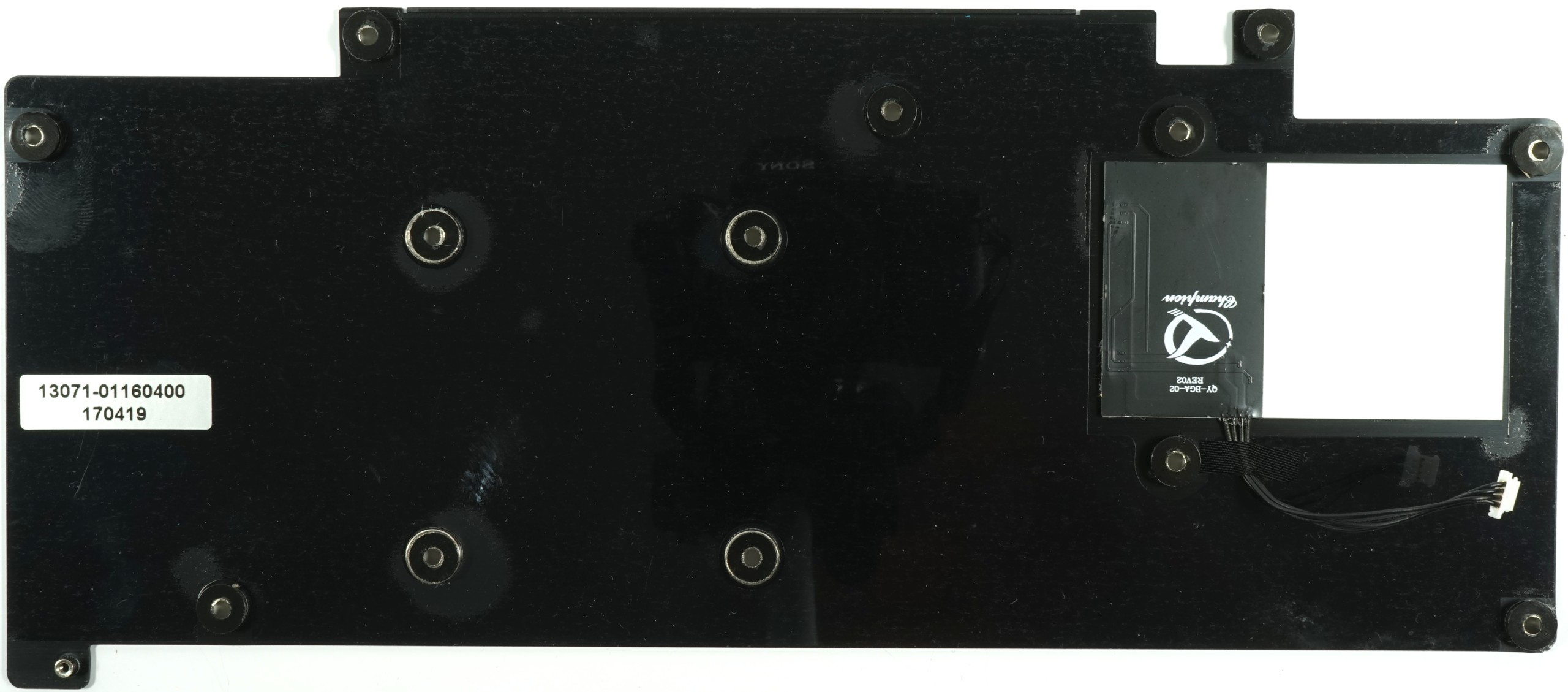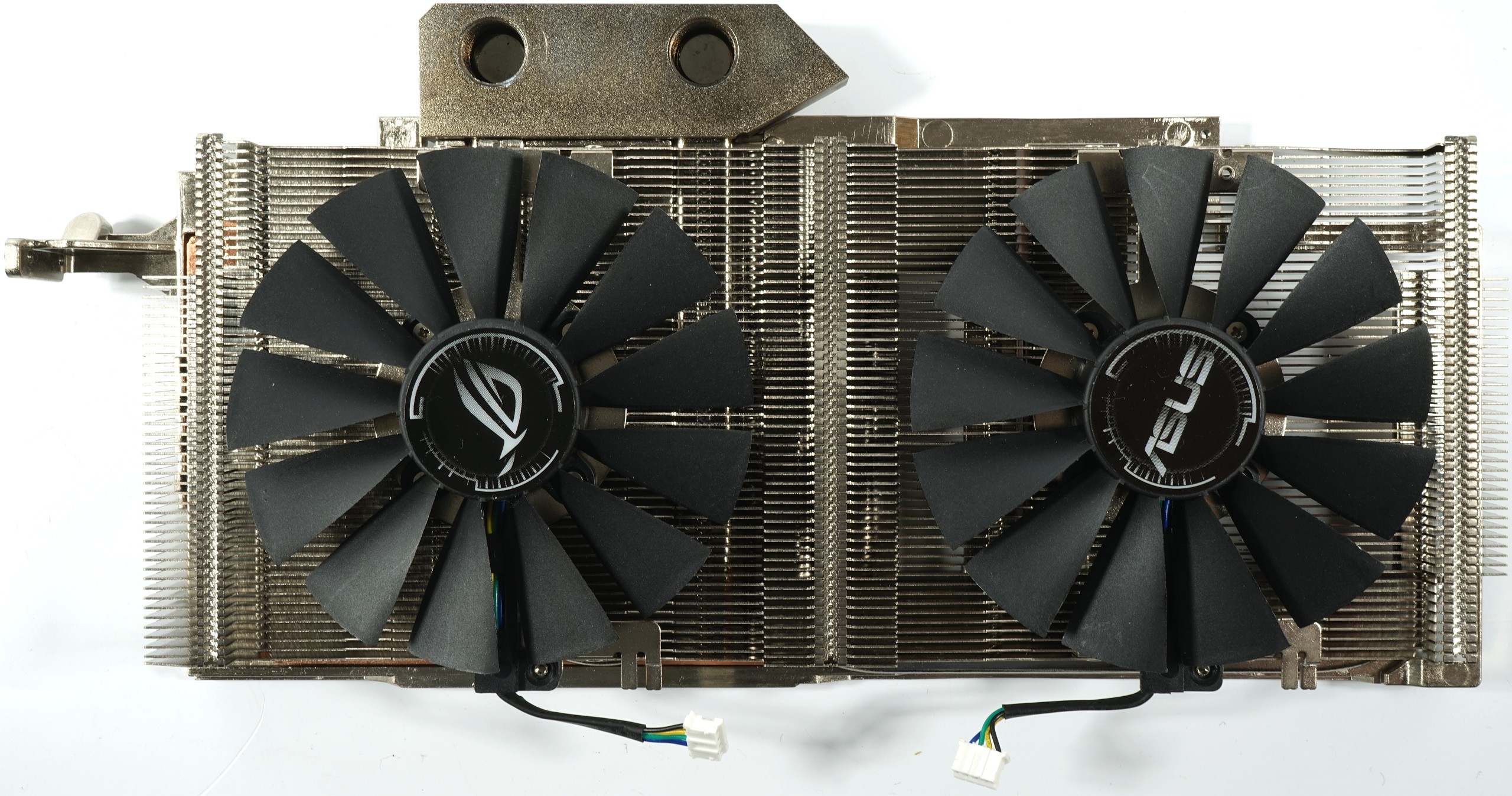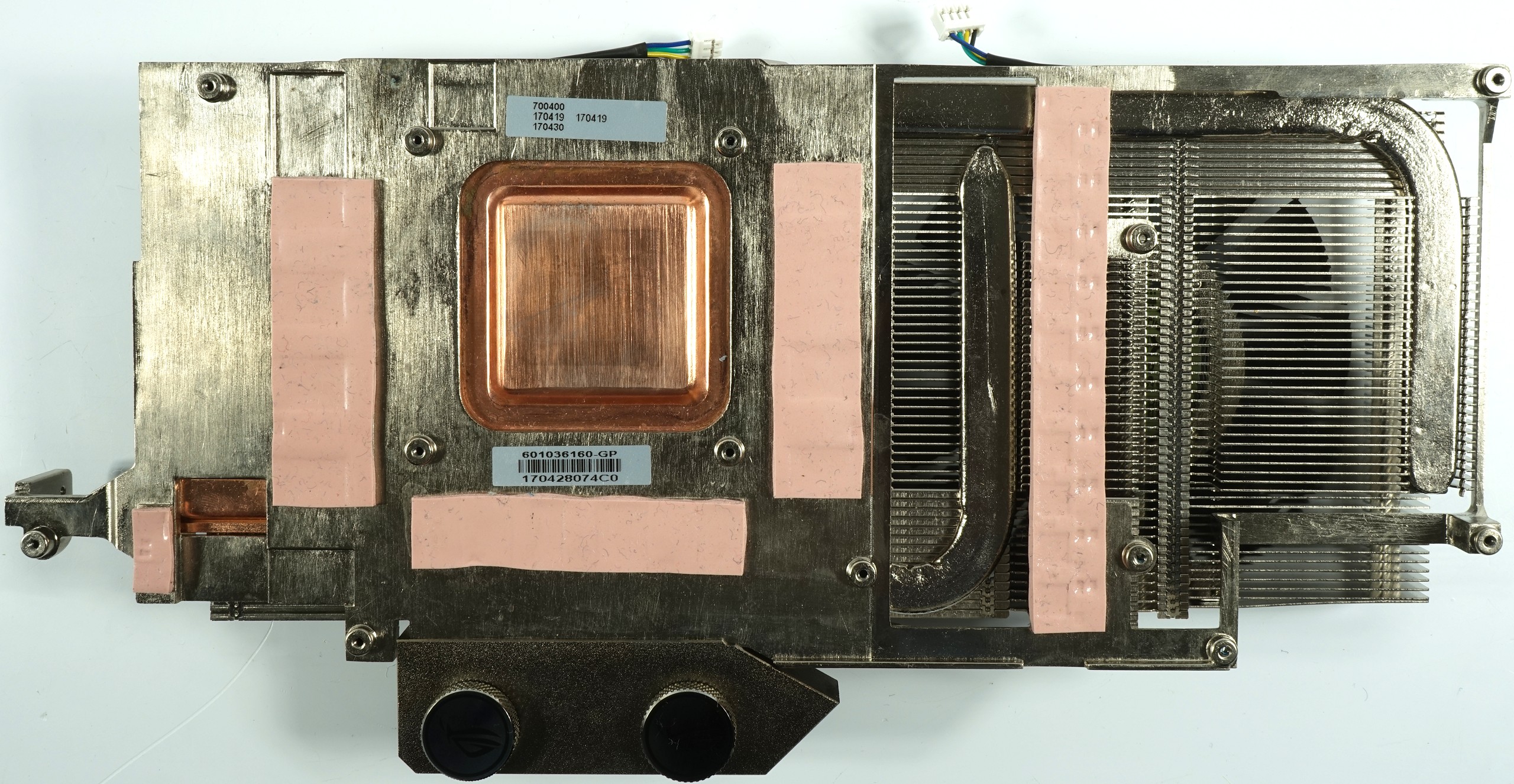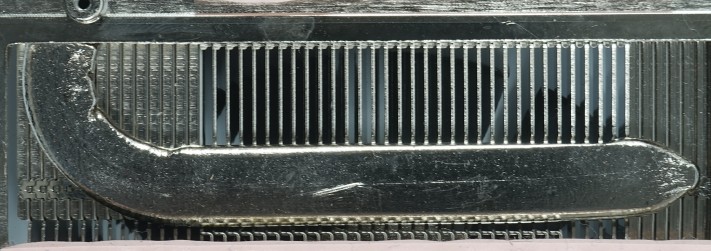Asus ROG Poseidon GeForce GTX 1080 Ti 11GB Platinum Edition Review
Why you can trust Tom's Hardware
Cooling & Noise
Cooling System & Backplate
Of course, this card's hybrid approach is what makes it unique from all of the other GeForce GTX 1080 Tis we've reviewed. You can choose for yourself whether you want water or air cooling. The advantage of this flexibility is that you don't have to sacrifice warranty coverage by swapping coolers if you start using the heat sink and fan, and later decide to incorporate a custom loop.
| Cooling System Overview | |
|---|---|
| Type | Hybrid thermal solution, supporting air and water cooling |
| Heat Sink | Copper sink with mounting frame Water cooling via attached U-shaped heat pipe to guide flow No micro-channels or other contact cooling |
| Cooling Fins | Aluminum, horizontal orientation Very narrow configuration Low depth |
| Heat Pipes | 2x 8mm, flat, and nickel-plated |
| VRM Cooling | Integrated onto the sinkOnly MOSFETs are cooled |
| RAM Cooling | Via mounting frame on heat sink |
| Fans | 2x 10cm fan modules 9.6cm rotor diameter 13 rotor blades, optimized for static pressure Semi-passive regulation |
| Backplate | Aluminum, blackened Foil-lined inside Does not aid cooling performanceIncludes back-lit logo |
The backplate is purely aesthetic. While it does sport a snazzy-looking ROG logo, it does nothing for cooling performance.
The thermal solution utilizes a copper sink that doubles as a block for water cooling (by guiding liquid through the hollow heat pipe). Its front and back both have outlets with standard screw threads, either of which can be used to connect hoses. It has to be mentioned, however, that depending on your cooler, Asus' narrow heat pipe may limit your flow rate. The company does claim its DirectCU H2O's in-channel throughput is 22% greater than the previous generation. But compared to a dedicated water block, performance isn't as high.
The big heat sink is based on a vapor chamber with a built-in water channel. Two additional heat pipes help transfer thermal energy to the array of aluminum fins. Asus says its 2.5-slot cooler provides 40% more surface area than its previous two-slot designs.
The inside radius of the heat pipes is narrow, and their quality is sub-optimal. Again, simple, flat pipes like these tend to limit performance by slowing down flow.
Fan Speeds And Noise
The fan curves indicate a conservative, volume-optimized setup. At GPU temperatures under 55°C, the fans don't spin at all.
| Fan Speed And Noise Output | |
|---|---|
| Fan Speed (Open Test Bench, Maximum) | 1884 RPM |
| Fan Speed (Open Test Bench, Average) | 1631 RPM |
| Fan Speed (Closed Case, Maximum) | 1801 RPM |
| Fan Speed (Closed Case, Average) | 1822 RPM |
| Noise (Air Cooling, Maximum) | 41.8 dB(A) |
| Noise (Air Cooling, Average) | 41.2 dB(A) |
| Noise ( Air Cooling, Idle) | 0 dB(A) |
| Acoustic Characteristics | Low-frequency bearing noise Audible motor noise <1HzBroadband bearing noise (clacking) Hardly any coil buzzing noise Audible air/tearing noise |
This snapshot illustrates the entire frequency range of our laboratory measurements, adding some data to our subjective observations.
Get Tom's Hardware's best news and in-depth reviews, straight to your inbox.
MORE: Best Graphics Cards
MORE: Desktop GPU Performance Hierarchy Table
MORE: All Graphics Content

Igor Wallossek wrote a wide variety of hardware articles for Tom's Hardware, with a strong focus on technical analysis and in-depth reviews. His contributions have spanned a broad spectrum of PC components, including GPUs, CPUs, workstations, and PC builds. His insightful articles provide readers with detailed knowledge to make informed decisions in the ever-evolving tech landscape
-
Pat Flynn I wonder how their cooler compares to something like EKWB's blocks? Temps/overclock wise that is.Reply -
dan88rx7turbo I have the Poseidon , sits at about 43c on load in Valley and Superposition 4k , 1080p extreme settings!Reply -
JackNaylorPE 1. The Poseidon is a great idea in concept but suffers from poor implementation.Reply
2. The addition of the PCB parts is a welcome addition. However w/o an explanation of how they differ from reference cards or compare to other AIB cards, it inda falls flat.
3. Benchmark Comparisons w/ just the reference model again leaves me wanting more. Asus Strix would at least allow comparisons to other AIB cards
.
4. And yes .... would have been very useful to compare against other options. An EVGA Hybrid and say the MSI Seahawk EK X (w/ full cover EK water block) would also be a big plus.
-
drmacaron i also have a poseidon. Super good temp dont know why the warer development aded maby if you should clocke it bigtime ?Reply -
mac_angel I have the Asus Strix 1080ti OC. It 'boosts' to 2Ghz on it's own. But playing with the curve in Afterburner, I get 2076MHz, on air. That's without flashing the ROMReply -
JackNaylorPE Reply20192947 said:I have the Asus Strix 1080ti OC. It 'boosts' to 2Ghz on it's own. But playing with the curve in Afterburner, I get 2076MHz, on air. That's without flashing the ROM
The OC is be expected ... from the article :
With sufficient water cooling, however, we were able to reach 2076 MHz. That's where our chip hit its ceiling, even after installing a high-end loop, increasing the power target, and applying a bit of extra voltage.
But outta the box, the boost is down at 1708 / 1709
http://www.tomshardware.com/reviews/asus-rog-poseidon-gtx-1080-ti-platinum,5151.html
-
Rheotome Both of these statements are incorrect:Reply
"lay down a flat heat pipe on a large sink and, as an option, send water through to dissipate thermal energy"
"The thermal solution utilizes a copper sink that doubles as a block for water cooling (by guiding liquid through the hollow heat pipe). "
No water flows through a heat pipe. A heat pipe is hollow, closed and sealed to contain the working fluid that evaporates and condenses to transfer heat from a hot to cold point.
The author is confusing heat exchanger and heat pipe technology. -
JackNaylorPE Actually, no ... there is no air involved in a heat exhangerReply
"A heat exchanger is a device used to transfer heat between a solid object and a fluid, or between two or more fluids."
The proper term here would simply "radiator tube" under normal circumstances ... as it is employed here, it's simply part of a hybrid water block, heat sink / radiator.





